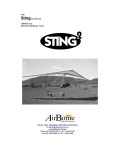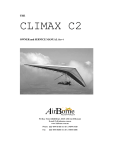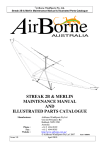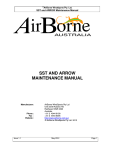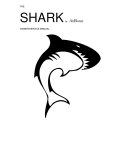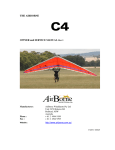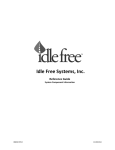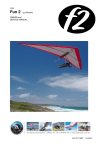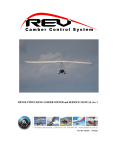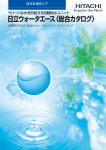Download Sting 3 Manual - Airborne Australia
Transcript
PART # 108841 THE Sting 3 by Airborne OWNER and SERVICE MANUAL, Rev 0 Photo here PO Box 7042, REDHEAD, NSW 2290 AUSTRALIA E-mail [email protected] www.airborne.com.au Phone (02) 4944 9199 Int +61 2 4944 9199 Fax (02) 4944 9395 Int +61 2 4944 9395 PART # 108841 THIS PAGE LEFT BLANK INTENTIONALLY TABLE OF CONTENTS TABLE OF CONTENTS .............................................................................................................. 3 Section 1 DESIGN FEATURES ............................................................................................... 5 Section 2 SPECIFICATIONS ................................................................................................... 6 Section 3 OPERATING LIMITATIONS .................................................................................... 7 Section 4 WARRANTY STATEMENT...................................................................................... 8 Section 5 ASSEMBLY PROCEDURE...................................................................................... 9 Section 6 PRE-FLIGHT INSPECTION ................................................................................... 13 HANG GLIDER DAILY INSPECTION....................................................................................................... 14 Section 7 BREAK DOWN PROCEDURE .............................................................................. 15 Section 8 ASSEMBLY FROM SHIPPING LENGTH .............................................................. 16 BREAKDOWN FOR SHIPPING .............................................................................................................. 16 Section 9 FLIGHT TECHNIQUE ............................................................................................ 17 TAKE OFF - DON’T FORGET TO HOOK IN.............................................................................................. 17 TURNS ............................................................................................................................................. 17 STALLS............................................................................................................................................. 17 SPINS ............................................................................................................................................... 17 THERMALLING ................................................................................................................................... 18 LANDING........................................................................................................................................... 18 Section 10 TUNING .............................................................................................................. 19 PITCH TRIM ...................................................................................................................................... 19 PITCH STABILITY SYSTEM................................................................................................................ 20 BRIDLE CHECKING SPECIFICATIONS ................................................................................................... 21 ROLL/YAW TRIM ............................................................................................................................... 22 ADJUSTING MAINSAIL BATTEN TENSION....................................................................................... 22 ADJUSTING BATTEN STRUT TENSION ........................................................................................... 22 Section 11 PERIODIC INSPECTIONS and MAINTENANCE............................................... 23 MAINTENANCE SCHEDULE ................................................................................................................. 23 LOG BOOK ........................................................................................................................................ 23 NOTES ON PERIODIC INSPECTIONS .................................................................................................... 23 Airframe Tubing 23 Bolts 24 Sails 24 INSPECTION AFTER HARD LANDING .................................................................................................... 25 DEFECT REPORTS ............................................................................................................................ 25 Section 12 TRANSPORTATION AND STORAGE ............................................................... 26 Section 13 MAINTENANCE RECORD ................................................................................. 27 Issue Date: 27 May 2008 Rev 0 Page 3 Section 14 HANG GLIDER COMPLIANCE SCHEDULES ................................................... 28 Section 15 ASSEMBLY DRAWINGS AND MATERIAL LISTS ............................................ 30 STING 3 X/BAR HINGE / PULLBACK ASM A4-7615 ...................................................................... 30 STING 3 X/BAR HINGE / PULLBACK ASM A4-7615 MATERIAL LIST ........................................... 31 STING II X-BAR LEADING EDGE JUNCTION A4-4716.................................................................. 32 STING II X-BAR LEADING EDGE JUNCTION A4-4716 MATERIAL LIST....................................... 33 REAR LEADING EDGE ASSEMBLY STING A4-6859 .................................................................... 34 STING II NOSE JUNCTION ASSEMBLY A4-4717 .......................................................................... 36 STING II NOSE JUNCTION ASSEMBLY A4-4717 MATERIAL LIST ............................................... 37 STING III KEEL ASSEMBLY A4-7608............................................................................................. 38 STING III KEEL ASSEMBLY A4-7608 MATERIAL LIST.................................................................. 39 CONTROL FRAME STING 3 PREASM A4-7625 ............................................................................ 40 CONTROL FRAME STING 3 PREASM A4-7625 MATERIAL LIST ................................................. 41 STING HANG LOOP ASSEMBLY A4-4796..................................................................................... 42 STING 2 & 3 SAIL TO AIRFRAME ASSEMBLY A4-4723 MATERIAL LIST..................................... 43 Issue Date: 27 May 2008 Rev 0 Page 4 Section 1 DESIGN FEATURES Classed as our "recreational" glider the Sting 3 is for the pilot that desires good performance with exceptional climb. A glider that is still very easy to launch and land. • • • Flying the new Sting 3, the things that stand out about the flying characteristics are: The very much improved glide performance. Ease of steering with the VG on. Great handling at low speed and maintaining manoeuvrability & controllability making it a very nimble yet stable glider to climb in thermals. The Sting 3 has an increased range of travel on the VG system. Landing the Sting is fun, with great low speed handling authority right up to an easy flare and touch down. The Sting 3 has a new luff curve at the heart of the design meaning that the sail has been entirely redesigned. Looking at the sail, the most recognisable difference is the undersurface layout and the increased amount of undersurface, particularly at the tips to improve the high speed glide performance. The Sting is constructed using 7075 airframe, fitted with faired king post, downtubes and speed bar as standard. The Sting includes a VG system as standard. • • • • • • • • • • • • • Features: Improved glide angle at inter thermal glide speeds. Lighter roll control at low speeds. Lighter roll control and more predictable docile stall with vg on. Lighter pitch pressures and easy aerotow using a shoulder attached tow bridle. Wider range of travel for the variable geometry system. New control frame, using the same control frame as used on the C4, with streamline downtubes, interchangeable control bar options including round speedbar, airfoil aluminium and airfoil carbon control bars - all changed by pip pins. New 7075 airframe. New sail luff curve. New airfoils. New top surface. New under surface, with increased double surface area for long XC glides. Improved under surface control with an additional batten. King post hang. Rick, Russell and Shane Duncan, Rob Hibberd and Paul Mollison AirBorne WindSports Issue Date: 27 May 2008 Rev 0 Page 5 Section 2 SPECIFICATIONS STING 3 154 METRIC IMPERIAL SAIL AREA 14.33 sq meter 154 sq ft WING SPAN 9.1 m 29.8 feet ASPECT RATIO NOSE ANGLE 5.7 121 degrees DOUBLE SURFACE % 75% BATTENS GLIDER WEIGHT 22 26 kg ASSEMBLY TIME 57 pound 7 min PACK UP LENGTH 5.5 meter 18.1 feet SHORT PACK LENGTH 3.9 meter 12.8 feet 50-100 kg 120-220 pounds VNE (Velocity Never to Exceed) 85 km/h 53 mph VA (Maximum rough air manoeuvring speed) 74 km/h 46 mph RECOMMENDED PILOT HOOK IN WEIGHT RANGE STING 3 175 (TBA) (Includes equipment) Note: The stall speed of the Sting 3 at maximum recommended wing loading is less than the minimum requirement of 25 mph (40 km/h). The maximum or steady state speed is at least 35 mph (56 km/h) for a prone pilot with correctly adjusted harness. Conversions: * 0.4536 kg/pound * 25.4 mm/inch * 1.609 km/mile Va = Test speed x 0.707 * Vne = Test Speed x 0.816 Issue Date: 27 May 2008 Rev 0 Page 6 Section 3 OPERATING LIMITATIONS WARNING Hang gliding is a high risk sport. The safe operation of this hang glider ultimately rests with you, the pilot. We believe that in order to fly safely you must maturely practice the sport of hang gliding. You should never fly this hang glider beyond the placarded limits. The velocity never to exceed (VNE) for your glider is given in Section 2, as is the maximum speed for manoeuvres or flying in rough air (VA). The indicated airspeeds given are for calibrated instruments mounted on, or near, the basebar of the control frame. During your initial flights on the glider it is recommended that you fly with an airspeed indicator until you are able to recognise the control feel that produces the airspeeds shown. Flight operations should be limited to non-aerobatic manoeuvres where the pitch angle does not exceed 30 degrees up or down to the horizon and where the bank angle does not exceed 60 degrees. Aggressive stalls and spins should not be attempted. Operations outside the recommended flight envelope, such as aerobatic manoeuvres or erratic pilot technique may ultimately produce equipment failure. You glider was designed for foot launched soaring and should not be flown by more than one person at a time. It should not be flown backwards or inverted. The setting up and breaking down of a hang glider, transportation on cars and flying itself will have an effect over time on its structural integrity. The glider will require maintenance as outlined in the maintenance section of this manual. Like any aircraft safety depends on a combination of careful maintenance and your ability to fly intelligently and conservatively. The owner and operator must understand that due to inherent risks involved in flying a hang glider, no warranty of any kind is made or implied against accidents, bodily injury and death, other than those which cannot by law be excluded. We hope that your new glider will provide you with many hours of safe flying. AIRBORNE. Issue Date: 27 May 2008 Rev 0 Page 7 Section 4 WARRANTY STATEMENT This warranty extends to new Hang Gliders and/or accessories and equipment manufactured by AIRBORNE WINDSPORTS PTY LTD (“Airborne”) and shall not embrace any other accessories or equipment in the sale. AIRBORNE warrants to the customer the hang glider and/or accessories manufactured or supplied by AIRBORNE to be free from defect in material and workmanship under normal use and service and of merchantable quality and fit the purpose for which they are ordinarily used. This Warranty will apply for a period of ninety (90) days from the date of dispatch of the hang glider not withstanding the number of hours flown but subject to the hang glider remaining the property of the customer. This warranty does not exclude any rights implied in favour of any customer by any applicable Federal and State legislation. AIRBORNE will make good any parts required because of defective material or workmanship as set out in the Warranty. THE WARRANTY WILL NOT APPLY TO: • Any mechanical adjustments, parts, replacements, repairs or other servicing that in the judgement of AIRBORNE are made or should be made as maintenance. • Any defect caused by any alteration or modification not approved by AIRBORNE. • Any defect caused by the fitment of parts that are not made or approved by AIRBORNE. • Any defect caused by misuse, accidents, negligence or failure to carry out proper maintenance. • Damage caused by continued operation of the hang glider after it is known to be defective. • Any defect or consequential loss, damage or injury caused by overloading. • Loss of use of the hang glider, loss of time, inconvenience, damages for personal injuries, loss of property or other consequential damages. • Failure due to wear and tear, accident, fire, incorrect or incomplete rigging and/or assembly, exposure to the elements, operation outside the placarded limitations and repairs attempted or made other than by AIRBORNE or its authorised agent. AIRBORNE will replace, free of charge, any original part that is determined by it to be defective under the terms of this Warranty and reserves the right to pay monetary compensation or make good the defect in any manner it deems appropriate. The customer is responsible for transporting the hang glider or parts to and from AIRBORNE or its authorised agent when making claims under this Warranty. The hang glider or parts are at the customer’s risk whilst in transit to and from AIRBORNE or its authorised agent. NOTE: Warranty service is available to the customer from AIRBORNE WINDSPORTS PTY LIMITED or authorised agent. Signed for and on behalf of AIRBORNE WINDSPORTS Issue Date: 27 May 2008 Rev 0 Page 8 Section 5 ASSEMBLY PROCEDURE The wing can be assembled in two positions, either lying flat or standing on the control frame. Assembling the Sting 3 on the control frame is the most popular method of assembly in light winds. This method is preferable as the sail is less prone to being soiled or damaged during assembly. In higher winds it is preferable to lay the glider flat for assembly with the nose into the wind until ready to launch. Our suggested sequence is as follows: Note: If resistance is encountered during any phase of set up or break down procedure stop and investigate. • UNZIP THE BAG. Lay the wing down with zip up and the nose facing approximately 120 degrees from the wind direction. The nose should be facing into the wind when assembling flat. Unzip the bag and unclip centre ties. Remove the bag of battens. • ASSEMBLE CONTROL FRAME. Spread the downtubes out. Connect the base bar using the pip pins, inserting them from front to rear. When a pip pin is secured correctly it passes completely through the downtube and base bar. Check that all the rigging wires are outside the control frame. Route the VG cord if necessary. • STAND GLIDER UP. Rotate the control frame to the vertical position and rotate the wing 180 degrees so that it is sitting on the base bar. If assembling flat ensure that control bar is central and the wires are not tangled. • REMOVE BAG. Remove the glider bag and unclip all of the ties. • SPREAD LEADING EDGES. Carefully spread both leading edges out half way then spread leading edges to their approximate flying position. IT IS ESSENTIAL THAT THE KEEL AND THE LEADING EDGES ARE KEPT IN THE SAME PLANE OR DAMAGE WILL RESULT. • RAISE KING POST. Raise the kingpost and attach the reflex bridles. Issue Date: 27 May 2008 Rev 0 Page 9 • • INSERT MAINSAIL BATTENS. Remove the battens from the bag. The red battens are for the left side and the green for the right. Insert the battens from the centre to the tip with gentle pressure, until the batten meets resistance. Shake the sail at the trailing edge whilst maintaining gentle pressure on the batten to allow the batten to be inserted over the cross bar. DO NOT FORCE THE BATTENS! • It is advised not to insert the last cambered tip batten and tip strut until the cross bars are tensioned. CLIPPING MAINSAIL BATTENS. Unclip ‘pivot beak’ from ‘threaded end’. Rotate pivot beak and locate in sail as shown. While supporting the underside of the batten, clip the pivot beak into the threaded end. To adjust batten load tension, release pivot beak from sail and rotate batten clip. THREADED END PIVOT BEAK • TENSION CROSS BARS. The cross bars are now tensioned by pulling the webbing loop until the shackle is positioned on the quick clip. Ensure that the catch is positively locked. - Issue Date: 27 May 2008 Rev 0 When tensioning with the glider lying flat the keel should be raised up to approximately 200 mm to allow the side flying wires to be loose. Page 10 • ATTACH REAR TOP WIRE. The rear top wire should now be attached to the rear quick clip block. • INSERT TIP BATTENS AND STRUTS. Remove tip bags. There is a strut each for the left side and right side. When holding the strut with the clip end toward you and with the clip hook facing up, the white clip should be outboard and then rotate toward the keel to tighten. The left hand side is pictured as a guide. The struts are floating and do not locate at the front other than by sliding them into their pockets. Locate the hook in the sail eyelet by moving the trailing edge onto the batten hook. Close the clip along the shaft gently but firmly. • INSERT UNDER SURFACE BATTENS. The under surface battens are inserted and pulled back into the rear of the batten pocket. • ATTACH FRONT FLYING WIRES. The ring on the front flying wires can now be inserted in to the quick clip block. Ensure that the catch is positively locked. If the glider has been assembled flat it should now be lifted on to the control frame. Take care to avoid the tip battens catching on the ground as you raise it. Keep a firm grip on the keel when raising the nose from the flat position in strong winds. Issue Date: 27 May 2008 Rev 0 Page 11 • INSERT NOSE BATTENS. Insert the nose battens tail end first and locate them on the fittings on the front of the keel. • INSTALL NOSE FAIRING. Attach the nose fairing by applying the top velcro first then gently tension over the nose plates and attach the velcro to the undersurface. • PRE-FLIGHT INSPECTION. You are now ready for the wing pre-flight inspection as outlined in the next section. It is imperative that you carry out this inspection every time you rig and before you fly. Issue Date: 27 May 2008 Rev 0 Page 12 Section 6 PRE-FLIGHT INSPECTION The wing was designed so that parasitic drag would be kept to a minimum. This means that most of the pre-flight checkpoints are enclosed. A thorough pre-flight inspection is mandatory for any aircraft, and the best technique is a circular walk around the wing. The nose area is the ideal place to start your pre-flight check, followed by each assembly point. Keep in mind the three most critical set up areas: • The nose quick clip. • Control bar corner assembly. • The cross bar tensioner quick clip. Starting at the nose we suggest the following checklist (ensuring all bolts and fasteners have the appropriate thread protruding beyond the nut). • Check the nose plate assembly ensuring that the king post wire is not kinked. Sight along both leading edges checking for similar curves. • Walk towards the tip feeling for dents in the leading edge. • Check cross bar/leading edge junction through the zipper access. • Check sail tip webbing is undamaged and is located properly in the slot. • Crouch down and lift wing tip to eye level to inspect that the rear leading edges is not damaged. • Walk towards the keel checking all battens are secured. • Check reflex bridle attachments are in order. • Check that the cross bar retaining shackle is secured on the quick clip. • Check the rear top rigging and that the reflex bridle wishart clip is properly closed. • Check king post base. • Repeat the above steps for the other side wing in reverse order. • Check all lower rigging is correctly routed and free from damage. The most likely area for damage on wires is around the swage and thimble area while kinks are more likely along the length of the wire. • Check control bar corners are correctly assembled with pip pins in place. • Ensure hang loops are correctly positioned and in good order. • Check control bar top assembly and ensure that the downtubes are straight. Issue Date: 27 May 2008 Rev 0 Page 13 • Unzip undersurface and check cross bar hinge and restraining strap. The VG should be operated and inspected to ensure it is functioning properly. • Ensure that the double surface is zipped up and nose fairing is secure. • Clip your harness into the main and back-up hang loops and perform a “hang check”. Make sure that your harness is the correct distance from the base bar, your leg loops are secure and your karabiner is locked. HANG GLIDER DAILY INSPECTION Inspection of the following items after every assembly of the glider is required: • Check for bends, dents, scratches in all tubes; • Check wire ends for bolt and/or other fastener security; • Check wires for twisted or jammed thimbles; • Check wires are free of kinks, frays, abrasions, broken strands etc; • Nose plate connections; • Tips secure; • Battens; • A-frame connections at the top and base on both sides; • Variable geometry operation (full and free movement); • Rear keel connections; • Cross-bar tension wire; • Cross-bar operation (free floating); • King post connections; • Reflex bridles - attached and tension correct; • Sail condition; • Harness straps and webbing secure, height adjustment correct; • Emergency parachute secure, correctly mounted and attached, operating handle accessible. Issue Date: 27 May 2008 Rev 0 Page 14 Section 7 BREAK DOWN PROCEDURE To break down your Sting 3, just reverse the set-up procedure steps as described. Included here are a few guidelines to follow which will save you time and prevent potential wear areas on your sail. It is possible to leave the nose battens in during daily operations! Note: If resistance is encountered during any phase of set up or break down procedure stop and investigate. • Remove nose fairing. • Remove tip struts and outer battens, and put on tip bags. • Let off the sail tension and pull each wing in slightly. • Pull out all the battens. • Attach top control bar padding. • Disconnect reflex bridle, attach wishart clip onto hole in sail, and attach rear quick clip padding. • Fold both wings in symmetrically, bringing both leading edges back at the same time. • Roll the sail up from the last reflex bridle. Roll the bridles into the sail. This will avoid tangling of the bridles during the set up procedure. One tie should be wrapped around the keel and leading edge to hold them together whilst the other side wing is rolled. • Place padding over the keel end and pullback clip. • Ensure that the sail is rolled into the leading edge pockets. It is important that the ties are not over tensioned as this can damage the mylar insert. Put tip bags on. • Place glider bag in position. • Roll the glider down gently onto its leading edges and undo the control bar pip pins. Remove the base bar. The VG cord can be left connected to the base bar. Attach downtube padding around the bottom of the downtubes. Undo the two centre ties and lay the downtubes between the leading edge pockets taking care not to kink any wires. • Place the battens between the outer leading edges with the curved ends toward the wing tips. Slide on the base bar padding and place the base bar alongside the battens. Secure the centre ties and zip up bag. For de-rigging flat, attach top control bar padding. Undo nose wires and pull wing forwards then follow steps as above. Issue Date: 27 May 2008 Rev 0 Page 15 Section 8 ASSEMBLY FROM SHIPPING LENGTH If your glider was delivered to you in the short pack form the following procedure should be used. • Unzip bag and remove ties. Remove all padding from the tube ends. • Assemble the control frame as described in the set up procedure section. Rotate the glider on to the control bar, lying flat on the ground. • Spread both leading edges approximately ½ metre. Remove the tip bags, which have been used as protection on the rear of the front leading edges. • Check rear leading edges for R (right) and L (left), a sticker on the end of the tubes defines the side. Insert rear leading edges in the appropriate side of the front leading edge with the slot on the rear leading edge facing upwards. Push on the leading edge and rotate slightly to ensure it is located correctly. It should be impossible to rotate the leading edge if correctly installed. • You are now ready to tension the sail. There are two webbing loops on the tip of the sail. The inside loop is for the sail tension and the outward loop is used to apply tension to locate the inside sail tension loop. A glider tie should be passed through the outward loop. Place one hand on the rear of the leading edge and the other through the tie. Pull sail firmly until the inside loop is located on the end of the leading edge. Rotate sail until the webbing is correctly located in the slot. Repeat for the other leading edge. If you find the above technique to tension the sail difficult the following method can be used: Remove the sail webbings from the front leading edge bolts. Locate the tip webbing in the slot on the rear leading edge. Slowly spread the leading edges out. Ensure the sail is able to move forward as the leading edges are spread, and is not caught on the front wire tang or damage will result. The cross bars can now be tensioned. Check once again the sail is OK at the nose. Re-attach nose webbing then let cross bar tension off. Your glider can now be fully assembled as outlined in the set up procedure. BREAKDOWN FOR SHIPPING Reverse the procedure above ensuring that all possible wear points are padded. Be sure to remove the nose battens from the sail and place in batten bag. Be careful when folding the sail as the mylar leading edge insert may be damaged. When you have finished packing the glider, place the front of the glider bag over the rear of the short packed glider. Zip up bag carefully and place the rest of the bag inside the package (the bag is installed back to front because it is tapered and the glider is bulkier at the rear when short packed). Issue Date: 27 May 2008 Rev 0 Page 16 Section 9 FLIGHT TECHNIQUE TAKE OFF - DON’T FORGET TO HOOK IN. The VG should be in the full off position. The Sting 3 has a slightly tail heavy static balance and is very easy to launch. Hold the nose approximately 20 degrees to the relative airflow with the wings level, accelerate quickly and smoothly to a fast run keeping the nose at the same angle. It is important that the pilot accelerates smoothly during the launch run. Too fast an acceleration will cause the nose to rise rapidly with the risk of stall on launch. TURNS The Sting 3 can be easily directed into a turn even at slow speeds, however for a fast roll rate and easier handling, it is best to pull on a little extra flying speed. The Sting 3 will maintain a turn until the turn is removed by pilot input. Allow yourself plenty of margin for safety. Don’t fly too slowly when scratching close to the hill. STALLS When practising stalls make sure you have sufficient altitude. Push out slowly (approx 1 mph per sec. speed reduction), the glider will tend to mush without dropping a wing. The sink rate will increase in this mush mode more than two fold. If you push out faster the nose will pitch higher, a gentle pitch down follows until the glider regains flying speed and recovers from the stall. Never stall the glider with the nose pitched up too high. This is a dangerous manoeuvre and can result in a tail slide and severe tumble. As a guideline, the angle at which the glider stalls results in a similar negative angle to recover. If you push out too much in a turn the glider will turn tighter unless you are flying very slowly, in which case you may tip stall. So keep on a little extra speed in turns until you get used to the glider. SPINS As with all the later design gliders the Sting 3 will resist spinning. If you do stall a wing in a turn and enter the initial stages of a spin, move your weight forward and to the high side of the rotation and the glider will recover. Issue Date: 27 May 2008 Rev 0 Page 17 THERMALLING The optimum speed for thermalling is a little above stall speed, it may be necessary to fly faster than this in rough conditions to maintain good control. Depending on the nature and area of the thermal a bank angle of between 10 and 50 degrees can be used. LANDING Landing is easy in the Sting 3. Your final approach should be a straight glide into the wind faster than trim speed, approx 25 mph (40 km/h). The VG should in the off position. Reduce air speed slowly keeping wings level. When the glider reaches trim speed a full flare is required. Flare smoothly and confidently by holding the uprights and pushing out and up. It is important that the pilot does not swing the legs forward whilst flaring. This results in the pilot’s centre of gravity moving forward which will cause the nose to drop. In strong wind it is possible to fly the glider onto the ground slowing up gradually. Be careful not to push out too hard in windy conditions. Issue Date: 27 May 2008 Rev 0 Page 18 Section 10 TUNING Your Sting 3 was test flown and delivered to you in trimmed ready to fly. If, however, any adjustments are made to your glider, we recommend that they be recorded in your maintenance log at the rear of this manual. If you feel that the glider requires adjustment to trim in the roll or pitch axis you should check that the problem is not caused by something asymmetrical in the frame or battens. In order of priority, check the following: • Ensure that the wires are correctly routed; • Check the battens against the profile; • Check that the battens have the same tension on both sides. Battens should be checked for normal and even operation; • Check that the keel is straight; • Check that the sail is correctly mounted on the leading edges; • Check leading edges are straight and the rear leading edges are located correctly; PITCH TRIM To make the glider trim faster move the main hang strap forward and to trim slower move the hang loop rearward. This is done by moving the king post forward or rearward, one hole at a time only. To move the hang strap, note the current position of the king post on the keel (eg using a pencil), unclip the front wire, let the tension off the cross bar, and ensure the side wires are loose. Undo the nut holding the king post in place, and carefully move the king post assembly to the new hole. The reserve hang loop can be moved as the king post assembly is moved. Re-attach the nut securing the king post being careful not to over-tighten, inspect and test fly. Issue Date: 27 May 2008 Rev 0 Page 19 PITCH STABILITY SYSTEM Stability in the pitch axis is provided by reflex in the root section. Alterations to the lengths of rigging, airframe or adjustments to the airfoil can have adverse effects on pitch stability. Reflex bridles provide pitch stability at low angles of attack. Correct attachment and adjustment of the reflex bridles is essential for maximum stability. A string line can be used to check the reflex bridles are correct. The line should be firmly stretched between the reflex bridle attachment eyelet on corresponding battens on the right and left side of the glider. Check the measurement from the string line to the top of the keel with the VG pulled all the way on. The glider should be standing on the control frame. It is important to support the keel off the ground from the rear flying wire attachment point otherwise the keel will flex and the measurements will be incorrect. String tension and measurement technique will cause variations of +/- 10 mm. This tolerance should be considered when checking against the following chart. Issue Date: 27 May 2008 Rev 0 Page 20 BRIDLE CHECKING SPECIFICATIONS REAR OF GLIDER REFLEX LINE ATTACHMENT REAR OF KEEL 4545.TCW Sting III 154 Batten # Metric Imperial 1 50 mm 1.9 “ 2 100 mm 3.9 “ 3 110 mm 4.3 “ 4 95 mm 3.7 “ Sting III 175 Metric Imperial 5 Note: VG is set full on. Issue Date: 27 May 2008 Rev 0 Page 21 ROLL/YAW TRIM Turns in gliders occur when they are asymmetrical. If you have a turn in your glider you should confirm that the six possible variables outlined at the beginning of this section have been checked. The following tables outline procedures for adjustments. Adjustments should be made to the glider in the sequence as listed. The glider should be tuned firstly in the VG off setting and then checked with the VG ½ and full on. NOTE: We refer to the fast wing as the wing on the high side of the turn i.e. The right wing is the fast wing if the wing is turning left and vice versa. MILD TURN VG OFF ADJUSTMENTS WHEN THE GLIDER IS CONFIGURED VG OFF TO 1/2 ON ADJUSTMENT METHOD Remedy left turn DIFFERENTIAL BATTEN TENSION. If the turn is mild, then increasing and decreasing the Increase tension on last 3 batten tension on either side can adjust it. If you increase battens on left hand side the tension on the slow side you are effectively putting by 2 turns at a time. more camber in the airfoil therefore creating more lift on that side. Decrease tension on last 3 If you decrease the tension on the fast side you are battens on right hand side decreasing the camber and reducing the amount of lift. The batten hinge clip can be rotated clockwise to by 1 turn at a time. decrease tension or anti-clockwise to increase tension. TIP PLUG ADJUSTMENT Rotate the right hand tip The tip plug can be rotated to increase or decrease lift on fitting clockwise if viewed either wing. The fast wing should have the tip fitting rotated from the rear of the leading upward to increase washout on that side. Requires 5/32” drill edge. The tip fitting should be rotated a maximum of 5 and rivet once rotated. mm. Remedy right turn Decrease tension on last 3 battens on left hand side by 1 turn at a time. Increase tension on last 3 battens on right hand side by 2 turns at a time. Rotate the left hand tip fitting anti-clockwise if viewed from the rear of the leading edge. The tip fitting should be rotated a maximum of 5 mm. ADJUSTING MAINSAIL BATTEN TENSION Batten tension can be set using the following guide: • Check batten is inserted fully into its pocket by pressing firmly on the end of the batten beak with the heel of your hand. The batten beak should protrude 5-7mm past the trailing edge when clip is closed. • Hook the beak in the sail and start to clip the batten, the beak should be at approximately 30 degrees to the batten shaft as tension starts to come on the clip, and should not be difficult to close. • With your eyes level with the trailing edge, look along the length of the batten toward the leading edge. As you close the clip and the sail tightens, the batten should start to make a small ridge on the sail near the leading edge - no more then a couple of millimetres. • Make adjustments of one full-turn at a time in between checking. ADJUSTING BATTEN STRUT TENSION • As you start to close the folding clip, tension should start to come onto the clip at approximately 30 degrees. • As the clip is closed, the sail should become tighter without obvious wrinkles. The clip should not be difficult to close. • Make adjustments of one full-turn at a time in between checking. Issue Date: 27 May 2008 Rev 0 Page 22 Section 11 PERIODIC INSPECTIONS and MAINTENANCE MAINTENANCE SCHEDULE 1 – Clean and service, 2 - Check as directed, 3 – Check for security, cracks, wear and faulty operation, 4 Remove, inspect and replace if necessary, 5 Recommend replacement or overhaul. MAINTENANCE REQUIREMENT Maintenance Period Period > Daily Monthl Three Six Every Every Every 4 y Month Monthly Year 2 Years s Years Flying 1 10 30 50 100 200 400 Days > Wing fabric deterioration and tears. 2 2 2 2 4 5 Wing fabric stitching. 2 2 2 2 2 Wing fabric attachment points. 3 3 3 3 3 3 Batten clip fittings 3 3 3 3 4 4 Check battens against template supplied. 2 2 2 2 2 2 Wing wires and attachment fittings. 2 3 3 4 4 5 5 Check leading edges, keel & A-frame for straightness, dents 2 2 2 4 4 4 and corrosion. Remove leading edges, cross bar, keel & A-frame structural 2 4 4 4 members and check for fatigue cracks radiating from drilled holes. Check reflex bridle luff lines for kinks. 2 2 2 2 2 2 2 Check Inspection zips. 2 2 2 2 2 2 Check variable geometry and compensator ropes, pulleys 2 3 3 3 4 4 5 and cleats. All bolts, nuts, washers & safety pins. At least one thread 2 2 2 2 2 2 showing outside each nut. Check hang straps and karabiners for wear or damage. 2 2 2 4 5 5 Check saddles and fittings for cracks. 2 2 2 4 4 5 It is recommended that: (a) those items marked 1,2 and 3 be performed by the owner of the glider; (b) those items marked 4 be performed by the owner in conjunction with another pilot; and (b) those items marked with a 5 be performed by Airborne or an accredited Airborne service agent. LOG BOOK When maintenance is performed always check appropriate square and make an entry in the maintenance log at the rear of this manual. NOTES ON PERIODIC INSPECTIONS AIRFRAME TUBING Installation & Removal When removing tubing do not bend or force tubes. When installing do not distort tubing from its original shape. Issue Date: 27 May 2008 Rev 0 Page 23 Inspection Inspect tubing for cracks, damage from abrasion, elongated holes or distortion in tube surface. Never attempt to repair tubing, always replace with new part. Inspect tubing for corrosion in and out. If corrosion is present the component should be replaced. Replacement Aluminium tube comes in many different sizes and grades. It is important that the correct replacement parts are used. BOLTS Installation & Removal • • • • After tightening, all bolts should have at least one thread showing. All self-locking nuts should not be installed more than two times. Be sure not to over-torque bolts when installing. Never deform a tube when tightening a bolt. Inspection Check bolts for bends, worn shanks, bad threads or corrosion. SAILS Sail Inspection • • • Check for tears in the fabric or any loose or unravelled seams. Check all inspection zippers to see if they function smoothly and close completely. Inspect tip webbing for damage. Sail may be repaired with appropriate sail tape or a sewn on patch. Airborne or an authorised agent should be consulted about sail repairs. Keep the sail clean of oil and dirt by washing the sail with soap and water. Keep the sail covered when not in use. CONTINUED EXPOSURE TO SUN DRAMATICALLY SHORTENS THE LIFE OF SAILS possibly to as little as six months. Issue Date: 27 May 2008 Rev 0 Page 24 INSPECTION AFTER HARD LANDING It is necessary to do a detailed inspection following any unusual stressing of the hang glider this full inspection should include all details listed for six-monthly maintenance. The inspection should be noted in the logbook, and any replacements recorded. DEFECT REPORTS Details of any defect which develops in service and which, if kept uncorrected, would compromise the continued safe operation of the hang glider should be reported to Airborne as soon as practicable. Issue Date: 27 May 2008 Rev 0 Page 25 Section 12 TRANSPORTATION AND STORAGE Avoid damage to your glider by using well-padded racks. We recommend that you support the glider in at least 3 places to spread the load. Flat straps should be used for tie downs to avoid damage to leading edge mylar. Store the glider in a dry room off the ground. Air the glider out regularly to avoid mildew, and never store wet. SAFE FLYING TEAM AIRBORNE Issue Date: 27 May 2008 Rev 0 Page 26 Section 13 Date MAINTENANCE RECORD Details of Repairs or Maintenance Issue Date: 27 May 2008 Rev 0 Carried out by Page 27 Section 14 HANG GLIDER COMPLIANCE SCHEDULES GLIDER MODEL: Sting 3 154 MANUFACTURED BY: AIRBORNE WINDSPORTS Pty Ltd NOTE: These specifications are intended only as a guideline for determining whether a given glider is a certified model and whether it is in the certified configuration. Be aware, however, that no set of specifications, however detailed, can guarantee the ability to determine whether a glider is the same model, or is in the same configuration as was certified, or has those performance, stability, and structural characteristics required by the certification standards. An owner’s manual is required to be delivered with each HGMA certified glider, and it is required that it contain additional airworthiness information. Weight of glider with all essential parts and without covers, padding and non-essential parts. Leading Edge Dimensions Nose plate anchor hole to crossbar attachment hole Nose plate anchor hole to rear sail attachment point Outside diameter at nose Outside diameter at cross bar Outside diameter at rear sail attachment point Crossbar Dimensions Overall pin to pin length from leading edge attachment point to hinge bolt at glider centre line Largest outside diameter Keel dimensions The cross bar centre load bearing pin The pilot hang loop Fwd Rear Sail Dimensions Chord length at 3 ft outboard of centre line Chord length at 3 ft inboard of tip Span (extreme tip to tip) Location of Information Placard Recommended Pilot Hook in Weight Range Recommended Pilot Proficiency NB: Metric 26.0 kg Imperial 57. lbs 3097 mm 5420 mm 50 mm 52 mm 50 mm 121.92” 213.39” 1.97” 2.05” 1.97” 2680 mm 105.51” 62 mm 2.44” 1290 mm 1600 mm 1630 mm 50.79” 63.00” 64.17” 2095 mm 82.48” 1070 mm 42.13” 9090 mm 357.87 “ Cross Bar 55-100 kg 120-220 lbs Intermediate Intermediate Conversions * 0.4536 kg/pound * 25.4 mm/inch * 1.609 km/mile All measurements taken with VG in the full on position. Issue Date: 27 May 2008 Rev 0 Page 28 THIS PAGE LEFT BLANK INTENTIONALLY Issue Date: 27 May 2008 Rev 0 Page 29 Section 15 ASSEMBLY DRAWINGS AND MATERIAL LISTS STING 3 X/BAR HINGE / PULLBACK ASM A4-7615 Issue Date: 27 May 2008 Rev 0 Page 30 STING 3 X/BAR HINGE / PULLBACK ASM A4-7615 MATERIAL LIST STING 3 X/BAR HINGE / PULLBACK ASM Part No - 108838 Material List for Drawing A4-7615 Item No 1 2 3 6 7 8 9 10 11 12 13 14 15 16 17 18 19 20 21 22 23 24 25 26 27 29 31 33 34 35 37 Description PULL BACK WIRE 1450 SIII 154 PULL BACK COVER NEOPRENE CABLE TIE (SHORT) 100 X 2.5MM BLACK BOLT AN4-12A NUT NYLOC AN4 HALF PULL BACK STRAP WITH TANGS SHACKLE BODY 1/4IN PULL BACK X/BAR SII 154 X/BAR BALL SKT TYPE 2 (WILLS WING) X/BAR BALL TYPE 2 (WILLS WING) BOLT AN3-30A BOLT AN4-30A WASHER NYLON 1/4IN OBA THIN WASHER AN4 NUT NYLOC AN4 FULL X/BAR STRAP TANG 230 WASHER AN3 NUT NYLOC AN3 FULL WASHER AN5 BOLT AN5-17A X/BAR BOLT COVER - 19MM SLOT WASHER NYLON M 8 STND CAP WASHER BASE CLIP M8 CAP WASHER COVER BLACK M8 NUT NYLOC AN5 HALF X/BAR ROPE SIII 154/175 PULLEY BLOCK RF20312 VG 3P POP RIVET 5/32 LONG(5-8) CORD NYLON STARTER WHITE 3.5 MM 16 PULLEY 30100NC X/BAR ROPE BUSH X/BAR BALL/SOCKET Issue Date: 27 May 2008 Rev 0 Drawing No A3-4506 A4-4789 A4-5605 A4-5450 A4-5561 A4-4633 A4-6338 A4-4678 A4-6460 A4-6459 A4-5449 A4-5450 A4-5540 A4-5540 A4-5535 A4-4633 A4-5540 A4-5535 A4-5540 A4-5493 A4-3090 A4-5540 A4-5667 A4-5666 A4-5561 A4-4726 A4-5515 A4-6448 Part No 109170 101900 101192 100547 100035 104291 102021 103529 102449 102409 100629 100011 103961 100042 100034 103626 100049 100051 100043 101244 103701 100595 100604 100603 100037 108833 102023 102417 109169 102027 102603 Quantity 2 1 1 1 1 1 1 2 1 1 2 2 6 2 2 1 4 2 1 1 1 4 1 1 1 1 1 2 4.15 1 2 Page 31 STING II X-BAR LEADING EDGE JUNCTION A4-4716 Issue Date: 27 May 2008 Rev 0 Page 32 STING II X-BAR LEADING EDGE JUNCTION A4-4716 MATERIAL LIST STING II, III X/BAR TO L/EDGE ASSEMBLY Part No - 108838 Material List for Drawing A4-4716 Item No 3 4 5 6 7 8 9 10 11 12 13 14 15 17 18 19 20 21 22 Description X/BAR MOUNT CHANNEL SADDLE 45MM TUBE SADDLE 60MM TUBE BOLT AN4-27A NUT NYLOC AN4 FULL TOP SIDE WIRE HG 2760 SIII 154 SIDE BTM WIRE SIII 2350 WASHER NYLON M 8 XOD BOLT AN4-26A VELCRO 50MM LOOP/BLACK ADHESIVE WASHER AN4 BOLT AN5-17A WASHER SS 5/16 X 1IN X 16G NUT NYLOC AN5 FULL NUT NYLOC AN4 HALF WASHER NYLON M 8 STND POP RIVET STST 6 - 6 3/16 BOLT AN4-22A VELCRO 25MM LOOP/BLACK ADHESIVE Issue Date: 27 May 2008 Rev 0 Drawing No A4-7009 A4-6842 A4-7166 A4-5450 A4-5535 A4-7208 A4-7202 A4-5540 A4-5450 A4-5540 A4-5493 A4-5540 A4-5535 A4-5561 A4-5540 A4-5515 A4-5450 Part No 102006 102271 100080 100010 100034 109150 108830 100820 100009 103289 100042 101244 100714 100036 100035 100595 102205 100549 104447 Quantity 2 4 2 2 4 1 2 4 4 0.32 4 2 2 2 2 2 2 2 0.28 Page 33 REAR LEADING EDGE ASSEMBLY STING A4-6859 Issue Date: 27 May 2008 Rev 0 Page 34 THIS PAGE LEFT BLANK INTENTIONALLY Issue Date: 27 May 2008 Rev 0 Page 35 STING II NOSE JUNCTION ASSEMBLY A4-4717 Issue Date: 27 May 2008 Rev 0 Page 36 STING II NOSE JUNCTION ASSEMBLY A4-4717 MATERIAL LIST STING 2002 NOSE JUNCTION ASSEMBLY Part No - 108838 Material List for Drawing A4-4717 Item No 1 2 3 4 5 6 7 8 9 10 11 13 14 15 Description BOLT AN4-26A WASHER AN4 NOSE PLATE HG TYPE 2 4MM TOP NOSE PLATE HG TYPE 2 4MM BTM SADDLE 45MM TUBE NOSE CLIP BLOCK TYPE 3 KEEL TUBE ASM SIII 154 L/EDGE FRONT S154 III WASHER NYLON M 6 XOD NUT NYLOC AN4 FULL SPRING QUICK CLIP GATE BOLT AN4-26 MODIFIED TOP FRNT WIRE HGWR 3415 SII,SIII 154 WASHER NYLON M 8 XOD Issue Date: 27 May 2008 Rev 0 Drawing No A4-5450 A4-5540 A4-4864 A4-4864 A4-6842 A4-4991 A4-7522 A4-5139 A4-5540 A4-5535 A4-7240 A4-4510 A4-7308 A4-5540 Part No 100009 100042 104273 104274 102271 104520 108827 104640 101055 100034 104275 104664 103505 100820 Quantity 3 4 1 1 3 1 1 2 4 4 1 1 1 1 Page 37 STING III KEEL ASSEMBLY A4-7608 Issue Date: 27 May 2008 Rev 0 Page 38 STING III KEEL ASSEMBLY A4-7608 MATERIAL LIST STING 3 KEEL ASSEMBLY Part No - 108838 Material List for Drawing A4-7608 Item No 1 2 3 3 3 3 6 7 8 9 11 12 13 14 15 16 18 23 24 30 33 34 35 36 37 38 39 Description SHOCK CORD 4MM ENDCAP FOR 42MM TUBE LUG NO HOLE SPRING QUICK CLIP BOLT SS QUICK CLIP BOLT PIN (AL) QUICK CLIP BLOCK BOLT QUICK CLIP AN5-24A TYPE 3 PULLEY RF20151ANC CHEEK BLOCK RVT M WASHER AN5 SADDLE 45MM TUBE CAP WASHER BASE CLIP M8 BOLT AN4-22A NUT NYLOC AN5 HALF NUT NYLOC AN4 HALF WASHER AN4 BOLT AN5-34A WASHER SS 5/16 X 1-1/4 304 FLAT K/POST BRACKET SS TYPE 2 D/TUBE TOP KNUCKLE S/LINE HG SPRING CLIP 1 PIN TYPE 1 SHOCK CORD 4MM POP RIVET 1/8 PULLEY BRACKET VG CLIMAX POP RIVET 5/32 SHORT(5-3) POP RIVET 5/32 MED 5-5 POP RIVET 5/32 LONG(5-8) NUT CASTLE AN4 SPLIT PIN M2.0 X 20 Issue Date: 27 May 2008 Rev 0 Drawing No A4-6468 A4-6467 A4-7002 A4-6453 A4-5540 A4-6842 A4-5667 A4-5450 A4-5561 A4-5561 A4-5540 A4-5493 A4-5540 A4-6873 A4-4947 A4-7464 A4-5515 A4-4914 A4-5515 A4-5515 A4-5515 A4-6297 A4-6296 Part No 100310 101728 101203 103277 106153 106561 104215 100043 102271 100604 100549 100037 100035 100042 100025 100045 103365 104308 102015 100310 100162 104252 102418 100161 102417 100040 100308 Quantity 1.15 1 1 1 1 1 1 4 1 2 1 2 2 1 1 2 1 2 2 1.2 2 1 1 1 1 1 1 Page 39 CONTROL FRAME STING 3 PREASM A4-7625 Issue Date: 27 May 2008 Rev 0 Page 40 CONTROL FRAME STING 3 PREASM A4-7625 MATERIAL LIST CONTROL FRAME STING 3 PREASM Part No - 108838 Material List for Drawing A4-7625 Item No 1 2 3 4 5 6 7 8 9 10 11 Description D/TUBE S/LINE SILVER 1650 D/TUBE BTM KNUCKLE S/LINE TYPE 2 RH D/TUBE BTM KNUCKLE S/LINE TYPE 2 LH SPRING CLIP 1 PIN TYPE 1 BUSH SS OD8X21.5L AEROS BEARING 12X8X3.5 (VG M/DRAG) CLEVIS PIN 3/16 X 29/32IN SPLIT RING 12MM RF114 FRNT FLYING WIRES SIII 154 2030 NO REAR FLYING WIRE HG SIII 154 2065 N NEOPRENE D/TUBE CVR Issue Date: 27 May 2008 Rev 0 Drawing No A4-4970 A4-6797 A4-6797 A4-7464 A4-5451 A4-5608 A4-5536 A4-5720 A4-4666 A4-4668 A4-4791 Part No 104458 107149 107148 102015 104964 105833 104572 100950 108828 108829 102020 Quantity 2 1 1 4 1 1 2 2 1 1 2 Page 41 STING HANG LOOP ASSEMBLY A4-4796 Issue Date: 27 May 2008 Rev 0 Page 42 STING 2 & 3 SAIL TO AIRFRAME ASSEMBLY A4-4723 MATERIAL LIST (Parts that may be purchased for repair/maintenance but are not listed on assembly drawings.) GLIDER STING 3 154 Part No - 108836 Material List for Drawing A4-4723 Item No 1 2 3 4 5 6 8 9 10 10 12 13 14 15 16 17 18 19 20 21 22 23 23 24 25 26 27 28 29 Description SAIL STING III 154 AIRFRAME STING 3 154 REFLEX BRIDLE 2X4 2925 SIII 154 WASHER SS 1/8 X 3/8IN WASHER SS 3/16 X 1/2IN SPLIT RING 12MM RF114 BATTEN SET SIII 154 HINGE PLACARD HANG GLIDING GENERIC L/EDGE REAR SIII LHS ASM L/EDGE REAR SIII RHS ASM FLIGHT MANUAL STING 3 BATTEN PROFILE STING 3 COVER TIP BAG ELASTIC BATTEN BAG LONG 2650 COVER KEEL QUICK CLIP HG 42MM COVER C/BAR CARBON S/LINE COVER CONTROL FRAME TOP HG COVER HG FRAME BTM GLIDER TIE COVER X/BAR SMALL GLIDER BAG S/BZ154 HANG LOOP 540 KPH RED HANG LOOP 630MM MYLAR L/E INSERT SIII 154 RETAINER LOOP 200MM D/TUBE TOP KNUCKLE 28X2 HG TYPE 2 COVER D/TUBE HG DOUBLE MITT COVER REAR KEEL HAT AIRBORNE LOGO ONLY Issue Date: 27 May 2008 Rev 0 Drawing No A4-7632 A4-7608 A4-7312 A4-5540 A4-5540 A4-5720 A4-7597 A4-6809 A4-6859 A4-6859 A4-4492 A4-6500 A4-7151 A4-7148 A4-6951 A4-7150 A4-7154 A4-7153 A4-7146 A4-7149 A4-7234 A3-7181 A4-7143 A4-7183 A4-4797 A4-6948 A4-4499 Part No 108837 108838 108831 101883 100569 100950 108839 107188 109175 109176 108841 108840 106481 106180 106183 107835 106184 106181 100139 102730 101669 101972 102120 108832 103667 104084 107779 102436 106513 Quantity 1 1 1 8 8 8 1 1 1 1 1 1 2 2 1 1 1 1 4 1 1 1 1 2 1 2 1 1 1 Page 43 THIS PAGE LEFT BLANK INTENTIONALLY Issue Date: 27 May 2008 Rev 0 Page 44












































